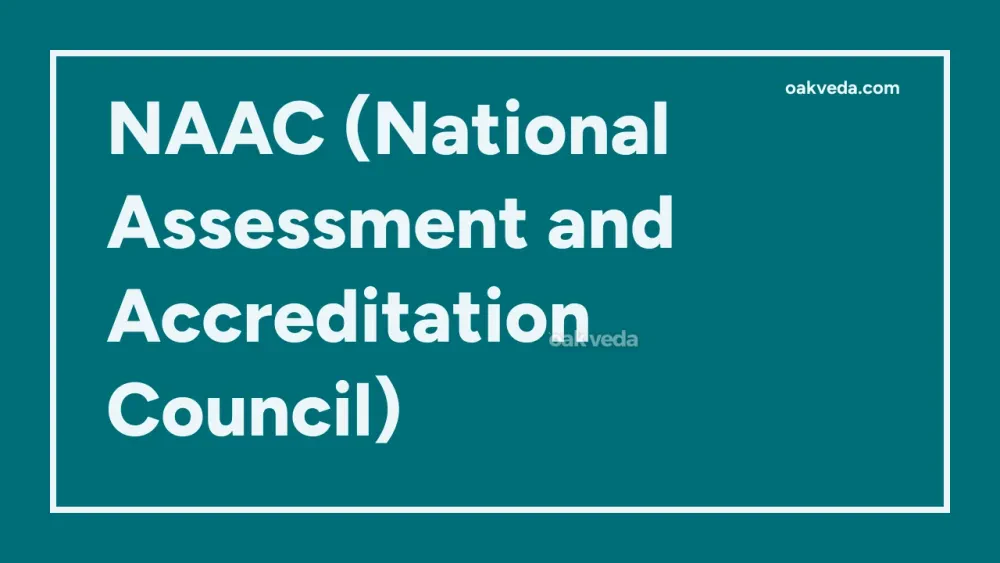
What is the Full Form of NAAC?
The full form of NAAC is National Assessment and Accreditation Council. This autonomous body plays a crucial role in evaluating and accrediting higher education institutions in India, ensuring quality standards are maintained across the country's educational landscape.
What is National Assessment and Accreditation Council?
The National Assessment and Accreditation Council (NAAC) is an organization established to assess and accredit institutions of higher education in India. It operates as an autonomous body under the University Grants Commission (UGC) and was founded in 1994 following recommendations from the National Education Policy. NAAC's primary objective is to enhance the quality of higher education through systematic evaluation, assessment, and accreditation processes.
Origin and Development of NAAC
NAAC was established in September 1994 with its headquarters in Bangalore, India. The organization was created in response to the growing need for quality assurance in the rapidly expanding higher education sector. Over the years, NAAC has evolved its assessment methodologies and criteria to keep pace with the changing educational landscape and global standards.
How does NAAC work?
NAAC operates through a multi-stage process to evaluate and accredit higher education institutions:
- Self-Study Report (SSR): Institutions prepare a comprehensive self-assessment report.
- Peer Team Visit: NAAC sends a team of experts to conduct on-site evaluations.
- Assessment: The peer team assesses various aspects of the institution based on predefined criteria.
- Grading: NAAC assigns a grade based on the institution's performance.
- Accreditation: Successful institutions receive accreditation for a specified period.
Functions of NAAC
The National Assessment and Accreditation Council performs several key functions:
- Conducting periodic evaluations of higher education institutions
- Grading institutions based on their performance and quality standards
- Promoting self-evaluation and continuous improvement in educational institutions
- Encouraging innovation and best practices in higher education
- Collaborating with stakeholders to develop and refine evaluation criteria
- Providing training and consultancy services to institutions seeking accreditation
Applications of NAAC
NAAC's accreditation has wide-ranging applications in the Indian higher education system:
- Quality Assurance: It serves as a benchmark for educational quality.
- Funding Decisions: Government bodies often consider NAAC grades for allocating funds.
- Student Choice: NAAC grades help students make informed decisions about their education.
- Global Recognition: NAAC accreditation enhances the international credibility of Indian institutions.
- Continuous Improvement: The process encourages institutions to maintain and improve their standards continually.
Features of NAAC
NAAC is characterized by several distinctive features:
- Comprehensive Evaluation: It assesses various aspects of an institution, including curriculum, teaching-learning processes, research, infrastructure, and governance.
- Transparency: The assessment process is transparent, with clearly defined criteria and methodologies.
- Peer Review: Evaluations are conducted by teams of experienced academicians and administrators.
- Grading System: Institutions are graded on a seven-point scale, from A++ to C.
- Periodic Reassessment: Accreditation is valid for a specific period, after which institutions must undergo reassessment.
Benefits of NAAC Accreditation
NAAC accreditation offers numerous benefits to educational institutions and stakeholders:
- Enhanced Reputation: Accredited institutions gain credibility and recognition.
- Improved Quality: The process encourages continuous quality improvement.
- Increased Funding Opportunities: Many funding agencies prefer NAAC-accredited institutions.
- Student Attraction: High NAAC grades can attract more students and faculty.
- Global Competitiveness: Accreditation helps institutions meet international standards.
- Stakeholder Confidence: It instills confidence among students, parents, and employers.
Limitations or Challenges of NAAC
Despite its benefits, NAAC faces several challenges:
- Resource Intensive: The accreditation process can be time-consuming and resource-intensive for institutions.
- Standardization Issues: Applying uniform criteria across diverse institutions can be challenging.
- Rapid Changes: Keeping up with fast-evolving educational trends and technologies.
- Maintaining Objectivity: Ensuring consistent and unbiased evaluations across different peer teams.
- Limited Coverage: Not all institutions in India are currently accredited by NAAC.
Future Developments in NAAC
NAAC continues to evolve to meet the changing needs of the education sector:
- Digital Transformation: Implementing more technology-driven assessment processes.
- Outcome-Based Evaluation: Shifting focus towards measuring learning outcomes and employability.
- International Collaboration: Strengthening partnerships with global accreditation bodies.
- Customized Frameworks: Developing specialized assessment frameworks for different types of institutions.
- Continuous Monitoring: Moving towards more frequent and ongoing assessment models.
FAQs on NAAC Full Form
-
What is the validity period of NAAC accreditation? NAAC accreditation is typically valid for five years.
-
Is NAAC accreditation mandatory for all higher education institutions in India? While not mandatory for all, it is highly recommended and often required for certain types of funding and recognition.
-
How often does NAAC update its assessment criteria? NAAC regularly reviews and updates its criteria to align with current educational standards and practices.
-
Can international institutions apply for NAAC accreditation? NAAC primarily focuses on Indian institutions, but it does consider applications from some foreign institutions operating in India.
-
How does NAAC contribute to the overall quality of higher education in India? By setting benchmarks, encouraging self-improvement, and promoting best practices, NAAC plays a crucial role in enhancing the overall quality of higher education in the country.
You may be interested in:
- SOP (Standard Operating Procedure) Full Form
- ACD (Automatic Call Distributor) Full Form
- HTML (Hypertext Markup Language): Full Form Explained
- MSME (Full Form): Ministry of Micro, Small and Medium Enterprises
- MBBS (Full Form): Bachelor of Medicine and Bachelor of Surgery
- TMB (Tamilnad Mercantile Bank Limited) Full Form

